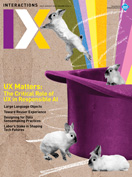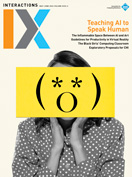Authors: Monica Granfield
Posted: Thu, May 02, 2013 - 12:35:41
This year’s CHI conference is "Changing Perspectives." It got me thinking about the perspective of design, and design by intuition in technology.
Perspective is the state of one’s idea or views, assumptions and beliefs, facts known to one. Proposing another way to look at something is often a way to change someone's perspective. Having an experience, good or bad, can change ones perspective. The current industry perspective on design seems to be focused on data-driven design, user-centered design, and standards-based design. The perspective is that design based on these methods is effective and justifiable design. However, what is missing from design is the intuitive aspect of designing the experiences we are creating. We need to consider how we can change our perspective on design in technology to support intuitive design and that sixth sense, because in that sixth sense lays the source of intuition and innovative designs.
We are always striving to make our designs in user experience more intuitive and innovative. However, if we are not designing from intuition, we are merely recreating what has already been done, using common components and making few strides into innovative interfaces and experiences. So why aren't we designing from intuition? Because it takes time, might cost more, no one else is doing it, it is the unknown, and it is not tangible.
According to graphic designer David Carson, "Intuition is the most important ingredient in design. Everyone has it, most schools discount intuition as part of the working process because you can't quantify it and can't teach it." So is the issue that most of us aren't familiar with utilizing and leading by intuition? Do we have these same barriers present in the work place? If we don't have an existing example to reference, data to quantify, or cause with which to justify a new idea or design, do we dismiss it for the sake of risk and time?
"The intuitive mind is a sacred gift and the rational mind is a faithful servant. We have created a society that honors the servant and has forgotten the gift." –Albert Einstein
When it comes to intuition, rather than facts, how does one justify intuition as a solution for a user-experience design?
Most times we design scientifically with a process. Many times we design reactively, piecing together a design based on existing knowledge. According to William Duggan, a professor at the Columbia School of Business, some intuition is derived from knowledge. This is what he has coined as "Expert Intuition," intuition based on knowledge, which allows you to make snap judgments, and only works in situations that are predicable and common. This is how most design is currently conceived today. This is not intuitive design and is not design that will innovate. According to Duggan, "Strategic Intuition" is what will lead us to true innovation. It is slow and works for new ideas. It may take a week to generate a new idea that comes to you in an ah-ha moment from your sixth sense. However, according to Duggan, our Expert Intuition often gets in our way of new thinking. It is easier to solve a problem with the known than wait for an answer from the unknown. This is where our perspective on design in user experience can change to truly support better design and innovation.
Duggan's theory on intuition explains so much. It explains why sitting in a room brainstorming and having a goal to leave that room with a solution is not always an optimal approach for design. It explains why after working on a product heads down for four months and finally having time to sit back and absorb the work, you are able to suddenly generate a half dozen cutting edge, innovative solutions to some of the most problematic areas in the experience. It explains why design needs time to absorb the UX problem before presenting a solution and why time for a design to change and morph may be better accommodated in an agile environment than in our product schedules. Intuition can drive and define an experience. This is not to say that you don't have to justify ah-ha moments with general processes like testing or feedback. It just tells you that based on experience or knowledge gained along the way, your feeling is guiding you and not the crowd or status quo. This perspective on design brings up how we look at where and how design fits into the overall process of creating a user experience.
“The intellect has little to do on the road to discovery there comes a leap in consciousness; call it intuition or what you will, and the solution just comes to you and don't from where or why.”
--Albert Einstein
As a design community we may inherently know this, feel this, and understand this. As a technology industry, can we change our perspective toward not only creating intuitive products, but around supporting intuitive design and our sixth sense in creating these products?
Posted in: on Thu, May 02, 2013 - 12:35:41
Monica Granfield
View All Monica Granfield's Posts






Post Comment
No Comments Found